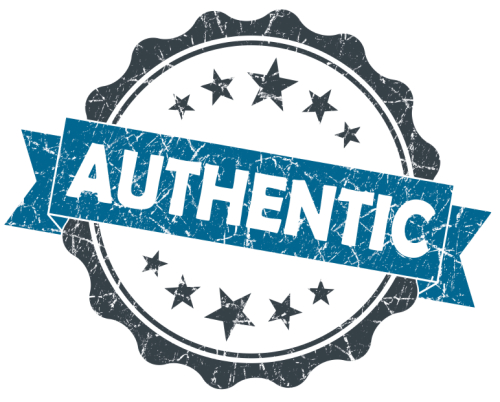Get Real! But How Far Should You Go?
Authenticity & all that jazz
Last week I got an email inviting me to my old school’s family fun day. Attached were some updates from people I hadn’t thought about for decades – decades that they’d distilled into a few sentences that communicated…what? What mattered to them, what they thought people would want to know or what was expected?
As always with these things, the real lives were there somewhere between the lines: lived in, enjoyed and endured, but with such limited information, impossible to know.
These thoughts brought to mind a conversation I’d had earlier that day with one of my clients who was adamant she wanted her customers to know every difficult, painful and personal detail of the journey she’d been on to set up her own business.
And with today’s emphasis on using storytelling to get our business messages across, the question has to be asked:
How real is too real?
How high should we turn up that dial of authenticity in our business communications?
Leaping that electric distance between people and connecting on an emotional level with your customers is a good thing. But are the lines between private and public, personal and professional becoming too blurred?
You could trace this predilection for authenticity or, if you’re feeling cynical – “manufactured authenticity” – back to the rise in popularity of the confessional genre. Publishers churned out so-called inspirational literature that soon became known as misery memoirs and it seemed that each new publication sought to out-do its predecessors.
To be human is to be vulnerable
More recently there’s been much said about how acknowledging vulnerability is a strength, helping you empathise and find common ground with others.
But Brené Brown who is at the forefront of this “vulnerability hangovers are good for us” movement is definitely not saying you should let it all hang out and eschew boundaries. That smacks of desperation and attention-seeking for its own sake.
Connection not therapy
Business communication shouldn’t be a stand-in for therapy. In therapy acknowledging a problem is a great thing – you’re nearly there, you’ve recognised something is amiss and now you can deal with it.
But that “nearly” is the operative word – there’s still some way to go. When you’re putting together content, be it blog post, presentation or your About Us page, you have to bear in mind its greater purpose – where it’s taking you. Not getting stuck at that “nearly” stage.
Failure in, and of itself, is rarely a destination. (Unless of course, you happen to be Nikki Durkin who wrote this brilliant illuminating piece on how it feels when your start-up fails, something that rarely has a spotlight shone on it. Her purpose though, in talking about failure, was to help others (who may find themselves in the position she was in) feel less isolated.)
“Failure porn”
So even when you’re being raw and honest – failure should, for the most part, be presented as a stage, something that happened, that you learned and moved on from. And not something you go on and on about.
Demian Farnworth and Jerod Morris in their excellent weekly podcast The Lede dared to ask the question – “Do we celebrate failure too much?”
Their perspective was that we’re in danger of glorifying failure, treating it too much like an essential badge of honour.
By the way, the rather marvellous phrase, “failure porn,” was coined by one of their previous guests, James Altucher.
How we can get it right
Keeping it real is of course highly personal. Something that ironically enough requires you to take a dispassionate step away from yourself.
Getting it right is particularly pertinent for the solopreneur, the small business owner who is his or her business. Although it’s a question of asking yourself what you’re comfortable with, it’s also very much about what your customers are or would be comfortable with.
There are no absolutes, no categorically right or wrong answers, it’s all to do with context and circumstances.
Celebrate those gems
When I’m copywriting it’s very often those gems that clients let slip in an unguarded moment that help create the character that comes through the copy. But it’s important to remember that not everything can, and should, be explicitly stated.
Those personal insights – your unique perspective – is how you differentiate yourself. It’s how you connect with your audience – showing how you arrived at your particular understanding of your market.
So be honest with yourself. Be aware of the why and what drives you, and do try to put it all in the context of a bigger picture – for example, how you fit into your industry niche, why you want to help people through your business.
Ask yourself these 6 simple questions:
1) What do you want this piece of marketing communication to do for your business?
2) What do you want your reader/audience to do next/think/feel?
3) Are you in danger of slipping over into emoting rather than evoking a feeling?
4) Is what you’re saying appropriate to the audience/s you’re addressing? For example, some parenting/new mum blogs are no-holds barred, over-sharingly honest (and their readers love them for it!).
5) Will you still feel this particular content is appropriate tomorrow/in the long run?
6) Are you ready and able to deal appropriately with the fall-out of potentially contentious content?
Don’t show (all) your cards all at once
So back to my client – who’d been through many hard times and much soul-searching to arrive at the point where she’d set up on her own:
There’s power in holding back, in keeping something in reserve and in imbuing your words with a hint of something more between the lines. The story won’t disappear, you’ll just find you can get more out of it.
Create connections and conversations with your customers. Over time, and with the benefit of them already knowing what you can do for them, tell more of your story. And make them very much a part of how your content develops.
And take care with what you put out there. Because putting the toothpaste back in the tube or unsaying something takes a whole lot more effort.
(Images: iStock.)


